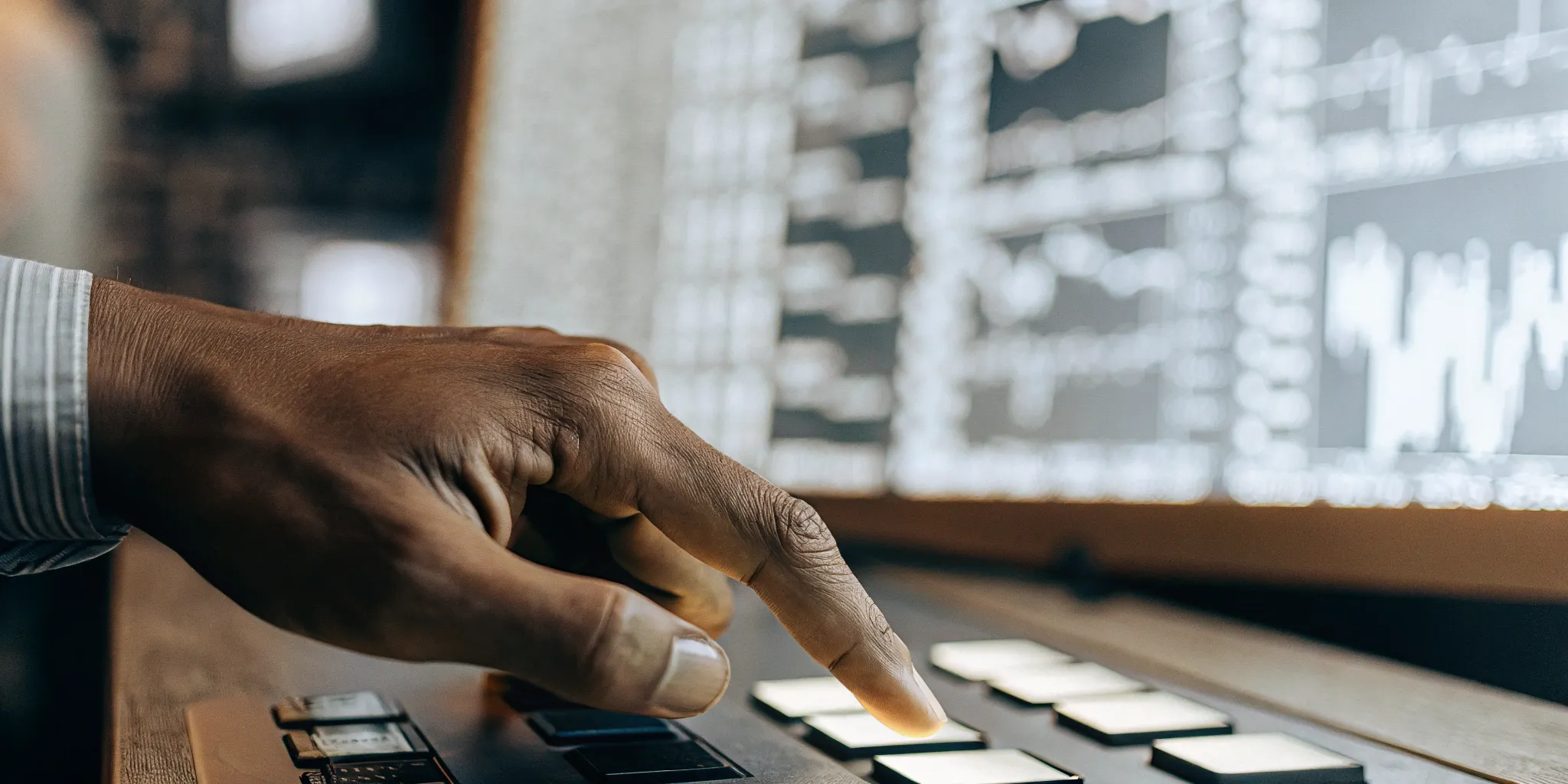Quantitative trading can feel intimidating, but artificial intelligence is making it easier than ever. AI empowers traders of all levels, from seasoned pros to curious beginners, to analyze markets and execute trades with speed and precision. This post breaks down how AI is transforming quantitative trading, offering practical insights to help you make smarter investment decisions and reach your financial goals. Ready to see how AI can give you an edge? Let’s explore the exciting world of AI-driven quantitative trading.
What is Quantitative Trading?
Key Takeaways
- AI-driven insights level the playing field: Retail investors can now access the same powerful market analysis previously enjoyed by large institutions, simplifying informed trading.
- Data-driven decisions minimize emotional bias: Algorithmic systems execute trades based on real-time data and pre-defined strategies, removing impulsive human actions from the equation.
- AI adapts to market shifts for consistent performance: Machine learning allows trading systems to continuously adjust to changing conditions, optimizing strategies for long-term profitability.
Definition and Explanation
Quantitative trading (quant trading) uses math and computer programs to make investment decisions. Unlike discretionary trading, which relies on gut feelings and qualitative analysis, quant traders use data and algorithms to identify and execute profitable trades. This approach removes emotional bias and allows for systematic, data-driven decisions.
Backtesting: Validating Your Strategies
A core component of quantitative trading is backtesting. Traders test their strategies using historical market data to see how they would have performed in the past. This helps evaluate the potential profitability and risk of a strategy before deploying it in live markets. Backtesting provides valuable insights into a strategy’s strengths and weaknesses under various market conditions.
Types of Quantitative Trading
Statistical Arbitrage
Statistical arbitrage uses statistical methods to identify temporary mispricings in related securities. Traders profit by exploiting these short-term discrepancies, expecting prices to revert to their mean. This strategy often involves complex statistical models and requires sophisticated data analysis.
Algorithmic Trading
Algorithmic trading automates the execution of trades based on pre-defined rules and algorithms. This eliminates human intervention and allows for faster, more efficient trading. Algorithmic trading can be used for various strategies, including statistical arbitrage, market making, and trend following.
High-Frequency Trading (HFT)
High-frequency trading (HFT) is a specialized form of algorithmic trading that involves executing a large number of orders at incredibly high speeds. HFT firms use powerful computers and low-latency connections to exploit fleeting market opportunities. This type of trading often focuses on tiny price discrepancies and requires advanced technology.
Data Used in Quantitative Trading
Market Data (Price and Volume)
Market data, including historical prices and trading volume, forms the foundation of quantitative trading. Traders analyze these data points to identify patterns, trends, and potential trading opportunities. Technical analysis indicators, derived from price and volume data, are often used in quantitative trading strategies.
Fundamental Data (Company Information)
Fundamental data, such as company financial statements, earnings reports, and industry trends, provides insights into a company’s intrinsic value. Quant traders may incorporate fundamental data into their models to assess the long-term prospects of an investment. This data can be combined with market data to create more comprehensive trading strategies.
Alternative Data (Satellite Imagery, Social Media)
Alternative data, including satellite imagery, social media sentiment, and consumer spending patterns, offers unique insights into market trends. Quant traders are increasingly using alternative data to gain an edge in the market. This data can provide valuable context and complement traditional market and fundamental data.
Key Components of a Quant Trading System
Strategy Identification
The first step in building a quantitative trading system is identifying a viable trading strategy. This involves researching market inefficiencies, developing hypotheses, and formulating a set of rules for entering and exiting trades. The strategy should be clearly defined and testable.
Strategy Backtesting
Backtesting is essential for evaluating the historical performance of a trading strategy. By simulating trades using past market data, traders can assess the strategy’s profitability, risk profile, and robustness under different market conditions. Thorough backtesting helps refine the strategy and identify potential weaknesses. For example, at FN Capital, our FAST AI algorithm undergoes rigorous backtesting to ensure its effectiveness.
Execution System
An execution system is the infrastructure that automates the buying and selling of assets based on the trading strategy’s signals. This system must be reliable, efficient, and capable of handling large volumes of trades. It connects to brokerage platforms and exchanges to execute orders in real-time. A robust execution system is critical for any quant trading operation, including those using advanced AI, like FN Capital’s FAST AI.
Risk Management
Risk management is crucial for protecting capital and ensuring the long-term viability of a quantitative trading system. This involves setting stop-loss orders, managing position sizes, and diversifying investments. Effective risk management helps mitigate potential losses and safeguards against unforeseen market events. FN Capital utilizes its proprietary DART (Dynamic Algorithmic Risk Tool) to manage risk in real-time.
Roles and Responsibilities in Quant Trading
Team Dynamics and Collaboration
Quant trading often involves a collaborative effort between various specialists, each contributing their expertise to the development and execution of trading strategies. Effective teamwork is essential for success in this fast-paced and complex field. For instance, at a firm like FN Capital, collaboration between AI specialists, data scientists, and financial experts is key to developing and refining our AI-powered trading strategies.
Quantitative Traders/Analysts
Quantitative traders are responsible for researching, developing, and implementing trading strategies. They use mathematical models and statistical techniques to identify profitable trading opportunities. They also monitor the performance of live trading strategies and make adjustments as needed.
Data Scientists/Quants
Data scientists play a crucial role in collecting, cleaning, and analyzing large datasets. They develop and test trading strategies using statistical methods and machine learning algorithms. They also contribute to the development of risk management models. At FN Capital, our data scientists play a vital role in optimizing the FAST AI algorithm.
Software Engineers/Machine Learning Engineers
Software engineers build and maintain the software systems that support the trading strategies. They develop and implement the execution systems, data pipelines, and other critical infrastructure. They also work closely with traders and data scientists to ensure the smooth operation of the trading platform.
Operations Managers
Operations managers oversee the day-to-day operations of the trading desk. They ensure compliance with regulations, manage risk, and coordinate with other teams within the firm. They also play a key role in maintaining the integrity and efficiency of the trading process.
Responsibilities of a Quant Trader
Asset Valuation
Quant traders use mathematical models to determine the fair value of assets. This involves analyzing market data, fundamental data, and other relevant information. Accurate asset valuation is crucial for identifying profitable trading opportunities. For example, at FN Capital, our AI-powered system constantly evaluates EUR/USD valuations to identify optimal entry and exit points.
Trade Execution
Quant traders execute trades based on the signals generated by their trading models. They use automated execution systems to buy and sell assets quickly and efficiently. Precise and timely trade execution is essential for maximizing profits. The FAST AI algorithm excels in this area, executing trades with speed and precision.
Risk Management
Quant traders are responsible for managing the risks associated with their trading strategies. They use various techniques, such as stop-loss orders and diversification, to mitigate potential losses. Effective risk management is crucial for preserving capital and ensuring long-term success. FN Capital prioritizes risk management through its DART system.
Skills and Education for a Quant Trading Career
Educational Background
A strong educational background in a quantitative field is typically required for a career in quant trading. Common degrees include mathematics, statistics, computer science, engineering, and finance. Advanced degrees, such as a Master’s or PhD, can be advantageous.
Essential Skills
Programming (Python, etc.)
Proficiency in programming languages like Python is essential for developing and implementing trading algorithms. Other relevant languages include C++, Java, and R. Strong programming skills are crucial for automating trading strategies and analyzing large datasets.
Data Analysis
Quant traders must be skilled in data analysis techniques to extract meaningful insights from large datasets. This includes statistical modeling, data mining, and machine learning. The ability to interpret and analyze data is crucial for identifying trading opportunities and managing risk.
Financial Modeling
Financial modeling skills are essential for valuing assets, forecasting market movements, and developing trading strategies. Quant traders must be proficient in building and using financial models to make informed investment decisions. This is a core competency for firms like FN Capital, where our financial models drive our AI-powered trading decisions.
Advantages and Disadvantages of Quantitative Trading
Advantages
Emotionless Decision-Making
One of the primary advantages of quantitative trading is its reliance on data and algorithms, which eliminates emotional bias from investment decisions. This leads to more disciplined and rational trading, reducing the impact of fear and greed on investment outcomes. Automated systems can process information and execute trades without being influenced by emotions, much like FN Capital’s FAST AI system.
Efficient Large Dataset Analysis
Quantitative trading systems can efficiently analyze vast amounts of data, far exceeding human capabilities. This allows traders to identify complex patterns and correlations that might be missed by traditional methods. Big data analytics provide a significant advantage in quantitative trading, enabling systems like FAST AI to process and interpret vast market datasets.
Disadvantages
Market Change Impact
Quantitative trading models are based on historical data and assumptions about future market behavior. If market conditions change significantly, a previously successful strategy may become ineffective. Market risk is an inherent factor in any trading strategy, including quantitative approaches. However, adaptive systems like FN Capital’s FAST AI are designed to adjust to evolving market dynamics.
Model Limitations
Even the most sophisticated quantitative models have limitations. Models are simplifications of reality and may not capture all the complexities of the market. Model risk can lead to unexpected outcomes, especially during periods of market volatility or unusual events. At FN Capital, we continuously refine our models to mitigate these risks.
Strategy Discovery by Competitors
If a quantitative trading strategy becomes widely known and adopted by other traders, its effectiveness may diminish. Competition can erode the profitability of a strategy as more traders exploit the same market inefficiencies. However, proprietary systems like FAST AI maintain a competitive edge through continuous innovation and adaptation.
Salary and Career Path in Quantitative Trading
Salary Expectations
Salaries for quantitative traders can vary widely depending on experience, skills, and location. However, quant trading is generally a high-paying field, with significant earning potential for successful traders. The increasing demand for AI expertise in quantitative trading, as seen at FN Capital, is further driving career opportunities and compensation in this field.
Career Progression and Opportunities
A career in quantitative trading can offer various opportunities for advancement. Experienced traders may progress to senior roles, such as portfolio manager or head of trading. Career progression often involves increasing responsibility and managing larger portfolios. The evolving landscape of AI-driven trading is creating new and exciting career paths within the industry, including roles focused on AI development and implementation, as exemplified at FN Capital.
How to Become a Quant Trader
Educational Path
Aspiring quant traders should pursue a strong educational foundation in a quantitative field, such as mathematics, statistics, computer science, or finance. A Master’s or PhD degree can be beneficial for advanced roles. For those interested in AI-driven trading, specializing in machine learning and artificial intelligence can be particularly advantageous.
Skill Development
Developing essential skills, such as programming, data analysis, and financial modeling, is crucial for success in quant trading. Practical experience through internships or personal projects can be valuable. Building a strong understanding of AI and machine learning principles is also becoming increasingly important in this field.
Online Resources and Certifications (e.g., CQF)
Various online resources and certifications, such as the CQF program, can provide specialized training in quantitative finance and trading. These resources can enhance skills and knowledge in the field. Additionally, exploring online courses and certifications in AI and machine learning can provide a valuable edge for aspiring quant traders.
FN Capital: AI-Powered Quantitative Trading Solutions
FAST AI Algorithm: The Next-Gen Quant Engine
FN Capital’s FAST AI algorithm represents a next-generation quantitative trading engine, leveraging the power of artificial intelligence to identify and exploit market opportunities. AI enhances the speed and accuracy of trading decisions.
EUR/USD Focus: Liquidity and Precision
By focusing on the EUR/USD currency pair, FN Capital ensures maximum liquidity and precision in trade execution. This minimizes slippage and enhances the efficiency of the trading strategy. AI further refines the accuracy of these trades.
DART: Dynamic Algorithmic Risk Tool
FN Capital’s DART (Dynamic Algorithmic Risk Tool) provides real-time risk management, adapting to changing market conditions and protecting capital. Dynamic risk management is essential in volatile markets.
Verified Performance and Transparency
FN Capital offers verified performance and transparency through its publicly available track record. This builds trust and provides investors with clear insights into the effectiveness of the AI-powered trading strategies. Transparency is a cornerstone of FN Capital’s approach.
1. Smarter Data Analysis
AI brings unparalleled efficiency to data processing in quantitative trading. Traditional models rely on limited datasets and manual analysis, often missing crucial market signals. AI-driven systems, however, can process massive amounts of real-time and historical data simultaneously. This level of precision allows traders to uncover patterns, trends, and opportunities that were previously inaccessible, enhancing decision-making and maximizing returns.
2. Improved Predictive Capabilities
At the heart of quantitative trading lies the ability to predict market trends. AI elevates this capability through sophisticated algorithms that detect subtle indicators of market shifts. By analyzing factors like sentiment, global events, and market behavior, AI provides traders with more accurate forecasts. This predictive power helps optimize trade timing and execution, significantly increasing profitability.
3. Real-Time Market Adaptation
The dynamic nature of markets requires quantitative trading systems to adapt quickly. AI enables real-time monitoring and adjustments, ensuring trading strategies align with current conditions. Whether it’s responding to unexpected volatility or seizing emerging opportunities, AI-driven platforms react instantly, keeping traders ahead of market trends and safeguarding profits.
4. Enhanced Risk Management
Managing risks effectively is a cornerstone of successful trading. AI-powered systems excel at identifying and mitigating risks by evaluating countless variables in real time. These systems simulate market scenarios, assess portfolio vulnerabilities, and suggest diversification strategies. By minimizing exposure to high-risk situations, AI fosters a safer trading environment for investors. AI’s continuous learning process ensures that risk management strategies evolve with changing market conditions, providing ongoing protection. This adaptive approach helps investors maintain stability even in volatile markets.
5. Cost-Effective Solutions
AI has democratized quantitative trading by reducing operational costs. Unlike traditional methods that require substantial resources and manual effort, AI automates complex processes and provides cost-efficient tools. This advancement makes trading accessible to small-scale investors and firms, leveling the playing field and encouraging broader participation in financial markets.
6. Continuous Learning for Long-Term Success
AI’s self-learning capabilities ensure continuous improvement in quantitative trading models. By analyzing past performance and adapting to evolving market dynamics, AI-driven systems refine their strategies over time. This adaptability not only enhances trading outcomes but also keeps models relevant in the face of ever-changing financial landscapes.
1. How does AI improve the accuracy of quantitative trading?
AI leverages machine learning algorithms to process vast datasets and identify trends, resulting in highly accurate market predictions and better-informed trading decisions. This allows traders to make quicker, more effective choices.
2. Can small-scale investors benefit from AI-driven quantitative trading?
Absolutely! AI-powered tools are cost-efficient and user-friendly, making quantitative trading accessible and effective for investors with varying levels of capital. These tools help level the playing field in competitive markets.
Revolutionizing Trading with AI Power
The power of AI in quantitative trading is transforming the financial world, making trading faster, smarter, and more accessible. With its ability to analyze data, predict trends, and adapt strategies, AI is redefining what’s possible in the realm of trading. From streamlining complex processes to enhancing decision-making accuracy, AI delivers unmatched advantages to traders of all levels. FN Capital leads this revolution, empowering investors to leverage AI for smarter trading decisions and consistent profits, paving the way for a more dynamic and inclusive financial future.
Related Articles
- AI’s Impact on Algo Trading
- Real-World Algorithmic Trading Examples & Strategies
- Predictive Analytics in Finance: A Practical Guide
- Algorithmic Trading Software 2025 Guide: Key Insights
- How Quantitative Trading Firms Work: Strategies and Impact – FN Capital
Frequently Asked Questions
What’s the difference between quant trading and regular trading? Regular trading often relies on intuition and market news, while quant trading uses mathematical models and automated systems to make trading decisions. It removes emotional biases and allows for faster, systematic trading based on data analysis.
Do I need a PhD to get involved in quant trading? While advanced degrees in math, statistics, or computer science can be helpful, they aren’t strictly necessary to start learning about quant trading. Many resources are available online, and practical experience with programming and data analysis can be just as valuable. Focus on building your skills and understanding of the core concepts.
What are the biggest risks of using AI in quant trading? Over-reliance on historical data is a key risk. Market conditions can change rapidly, and models built on past data may not accurately predict future performance. Also, while AI can manage risk, it’s not foolproof. Unexpected market events can still lead to losses. It’s important to have a diversified approach and understand the limitations of any trading system.
How can AI make quant trading more accessible to everyday investors? AI-powered platforms are automating complex tasks and making sophisticated tools more user-friendly. This reduces the technical expertise needed to get started and makes quant trading more cost-effective for smaller investors. Look for platforms that offer educational resources and transparent performance data.
What is the role of backtesting in developing a quant trading strategy? Backtesting is like a dress rehearsal for your trading strategy. It involves simulating your strategy using historical market data to see how it would have performed in the past. This helps you identify potential flaws, refine your approach, and gain confidence before risking real capital in live markets.





